Essendon Food Solutions: Dynamic Strategy and Disruptive Innovation
VerifiedAdded on 2022/10/10
|11
|3058
|13
Case Study
AI Summary
This case study examines Essendon Food Solutions (EFS), a multinational food ingredient company founded in 1979, focusing on its internal structures, external factors, marketing perspectives, and technology implementations. The analysis highlights issues within human resources, organizational culture, and resource allocation, stemming from ineffective recruitment and top-down decision-making. External commitments, regulations, and the need for improved stakeholder relationships are also discussed. The marketing perspective reveals a lack of a proper marketing team, hindering customer engagement and market expansion. Technologically, the R&D department faces challenges in innovation and customer interaction. Recommendations include restructuring the HR department, fostering better stakeholder relationships, empowering employees to share ideas, establishing a technical sales team, and enhancing the R&D department's capabilities. The study emphasizes the importance of dynamic strategies and disruptive innovation for EFS to maintain competitiveness and achieve sustainable growth.
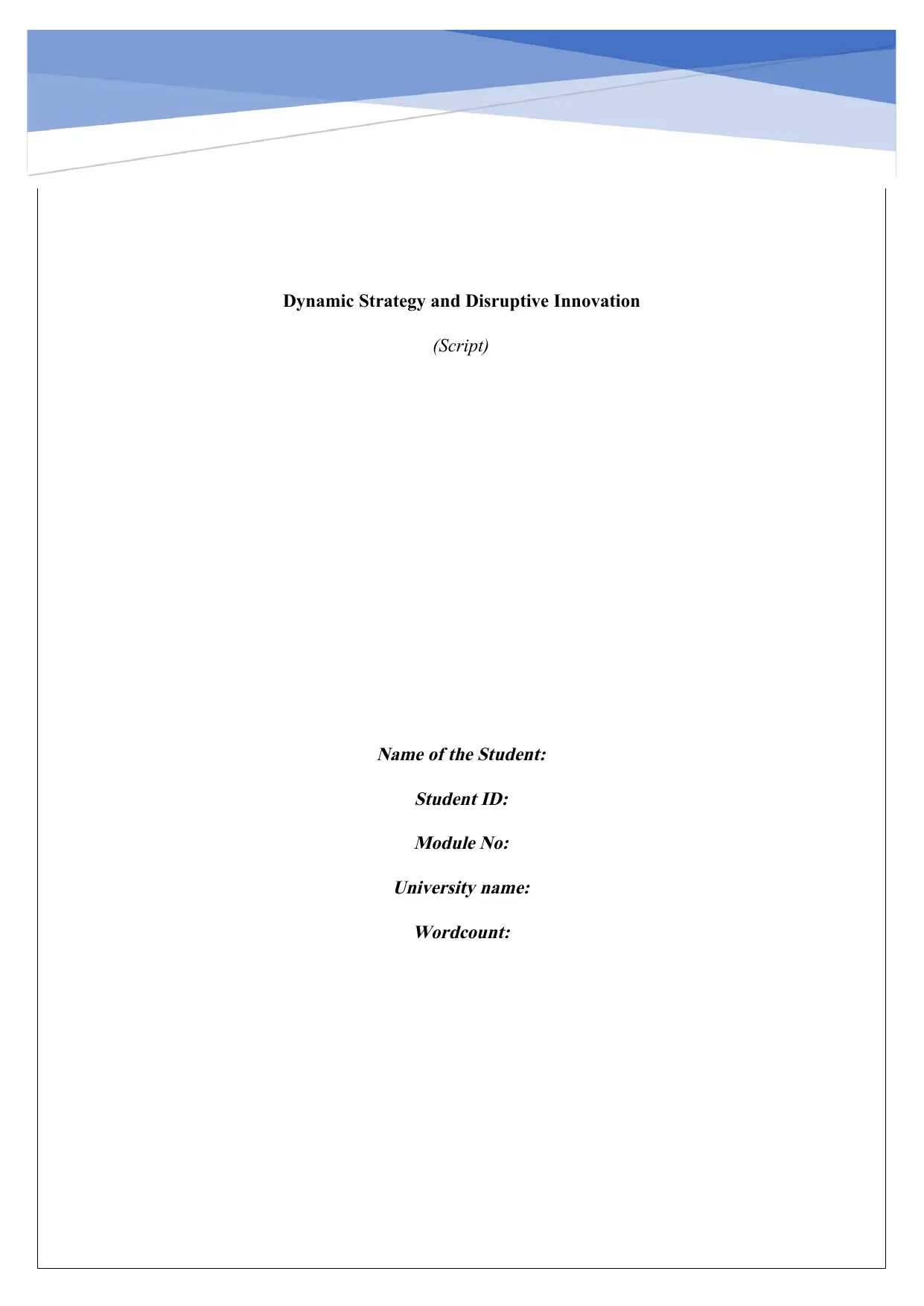
Dynamic Strategy and Disruptive Innovation
(Script)
Name of the Student:
Student ID:
Module No:
University name:
Wordcount:
(Script)
Name of the Student:
Student ID:
Module No:
University name:
Wordcount:
Paraphrase This Document
Need a fresh take? Get an instant paraphrase of this document with our AI Paraphraser

DYNAMIC STRATEGY AND DISRUPTIVE INNOVATION
Table of Contents
1. Introduction............................................................................................................................2
2. Internal perspective................................................................................................................2
2.1 Human resources:.............................................................................................................2
2.2 Organisational culture:.....................................................................................................2
2.3 Resource allocation:.........................................................................................................3
2.4 Recommendation:.............................................................................................................3
3. External view 3
3.1 Commitments...................................................................................................................3
3.2 Regulations.......................................................................................................................4
3.3 Recommendation:.............................................................................................................4
4. Marketing perspective............................................................................................................4
4.1 Recommendation:.............................................................................................................5
5. Technology perspective.........................................................................................................6
5.1 Recommendation:.............................................................................................................6
6. Conclusion..............................................................................................................................7
7. References..............................................................................................................................8
Page 1 of 11
Table of Contents
1. Introduction............................................................................................................................2
2. Internal perspective................................................................................................................2
2.1 Human resources:.............................................................................................................2
2.2 Organisational culture:.....................................................................................................2
2.3 Resource allocation:.........................................................................................................3
2.4 Recommendation:.............................................................................................................3
3. External view 3
3.1 Commitments...................................................................................................................3
3.2 Regulations.......................................................................................................................4
3.3 Recommendation:.............................................................................................................4
4. Marketing perspective............................................................................................................4
4.1 Recommendation:.............................................................................................................5
5. Technology perspective.........................................................................................................6
5.1 Recommendation:.............................................................................................................6
6. Conclusion..............................................................................................................................7
7. References..............................................................................................................................8
Page 1 of 11
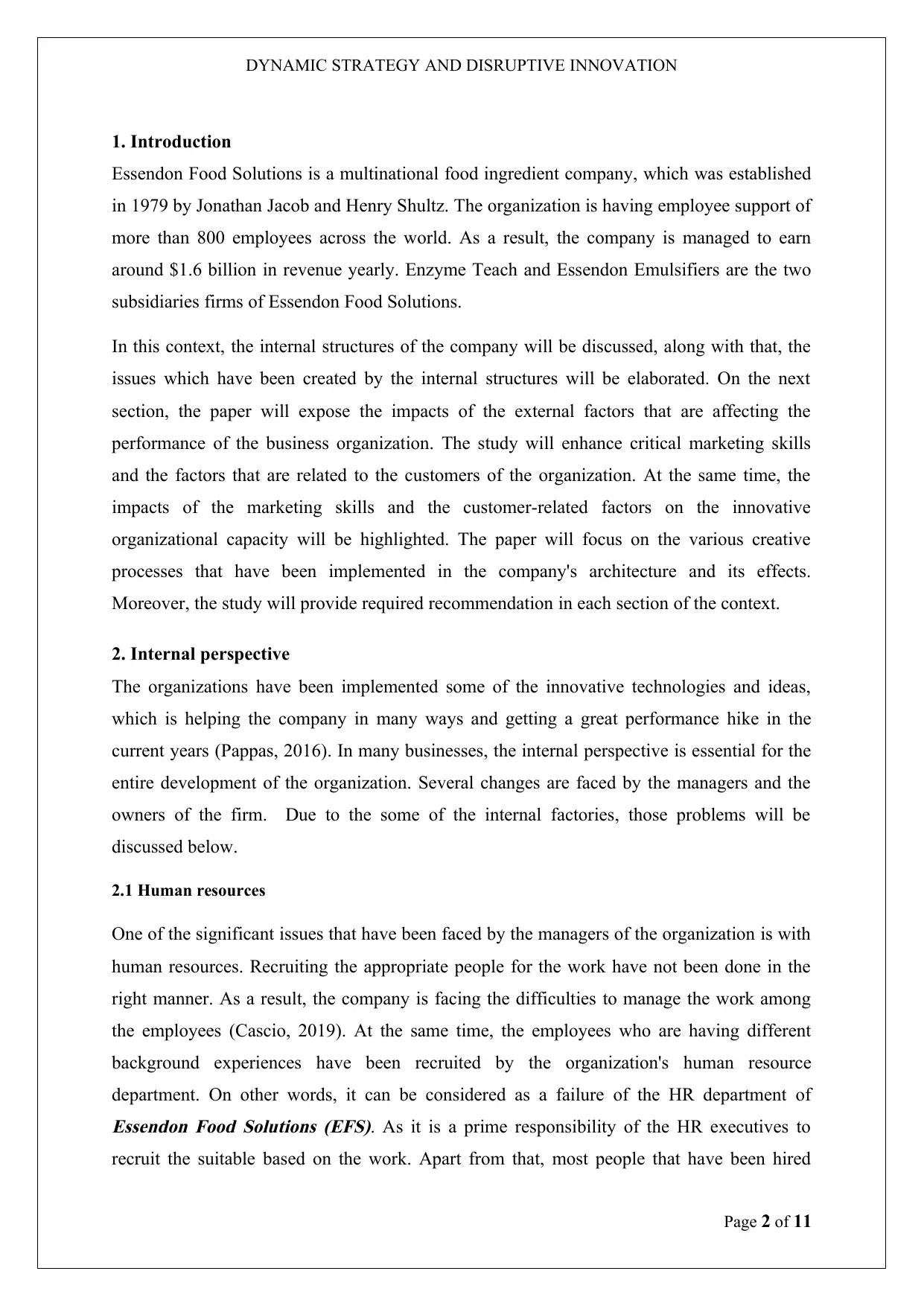
DYNAMIC STRATEGY AND DISRUPTIVE INNOVATION
1. Introduction
Essendon Food Solutions is a multinational food ingredient company, which was established
in 1979 by Jonathan Jacob and Henry Shultz. The organization is having employee support of
more than 800 employees across the world. As a result, the company is managed to earn
around $1.6 billion in revenue yearly. Enzyme Teach and Essendon Emulsifiers are the two
subsidiaries firms of Essendon Food Solutions.
In this context, the internal structures of the company will be discussed, along with that, the
issues which have been created by the internal structures will be elaborated. On the next
section, the paper will expose the impacts of the external factors that are affecting the
performance of the business organization. The study will enhance critical marketing skills
and the factors that are related to the customers of the organization. At the same time, the
impacts of the marketing skills and the customer-related factors on the innovative
organizational capacity will be highlighted. The paper will focus on the various creative
processes that have been implemented in the company's architecture and its effects.
Moreover, the study will provide required recommendation in each section of the context.
2. Internal perspective
The organizations have been implemented some of the innovative technologies and ideas,
which is helping the company in many ways and getting a great performance hike in the
current years (Pappas, 2016). In many businesses, the internal perspective is essential for the
entire development of the organization. Several changes are faced by the managers and the
owners of the firm. Due to the some of the internal factories, those problems will be
discussed below.
2.1 Human resources
One of the significant issues that have been faced by the managers of the organization is with
human resources. Recruiting the appropriate people for the work have not been done in the
right manner. As a result, the company is facing the difficulties to manage the work among
the employees (Cascio, 2019). At the same time, the employees who are having different
background experiences have been recruited by the organization's human resource
department. On other words, it can be considered as a failure of the HR department ofEssendon Food Solutions (EFS). As it is a prime responsibility of the HR executives to
recruit the suitable based on the work. Apart from that, most people that have been hired
Page 2 of 11
1. Introduction
Essendon Food Solutions is a multinational food ingredient company, which was established
in 1979 by Jonathan Jacob and Henry Shultz. The organization is having employee support of
more than 800 employees across the world. As a result, the company is managed to earn
around $1.6 billion in revenue yearly. Enzyme Teach and Essendon Emulsifiers are the two
subsidiaries firms of Essendon Food Solutions.
In this context, the internal structures of the company will be discussed, along with that, the
issues which have been created by the internal structures will be elaborated. On the next
section, the paper will expose the impacts of the external factors that are affecting the
performance of the business organization. The study will enhance critical marketing skills
and the factors that are related to the customers of the organization. At the same time, the
impacts of the marketing skills and the customer-related factors on the innovative
organizational capacity will be highlighted. The paper will focus on the various creative
processes that have been implemented in the company's architecture and its effects.
Moreover, the study will provide required recommendation in each section of the context.
2. Internal perspective
The organizations have been implemented some of the innovative technologies and ideas,
which is helping the company in many ways and getting a great performance hike in the
current years (Pappas, 2016). In many businesses, the internal perspective is essential for the
entire development of the organization. Several changes are faced by the managers and the
owners of the firm. Due to the some of the internal factories, those problems will be
discussed below.
2.1 Human resources
One of the significant issues that have been faced by the managers of the organization is with
human resources. Recruiting the appropriate people for the work have not been done in the
right manner. As a result, the company is facing the difficulties to manage the work among
the employees (Cascio, 2019). At the same time, the employees who are having different
background experiences have been recruited by the organization's human resource
department. On other words, it can be considered as a failure of the HR department ofEssendon Food Solutions (EFS). As it is a prime responsibility of the HR executives to
recruit the suitable based on the work. Apart from that, most people that have been hired
Page 2 of 11
⊘ This is a preview!⊘
Do you want full access?
Subscribe today to unlock all pages.

Trusted by 1+ million students worldwide
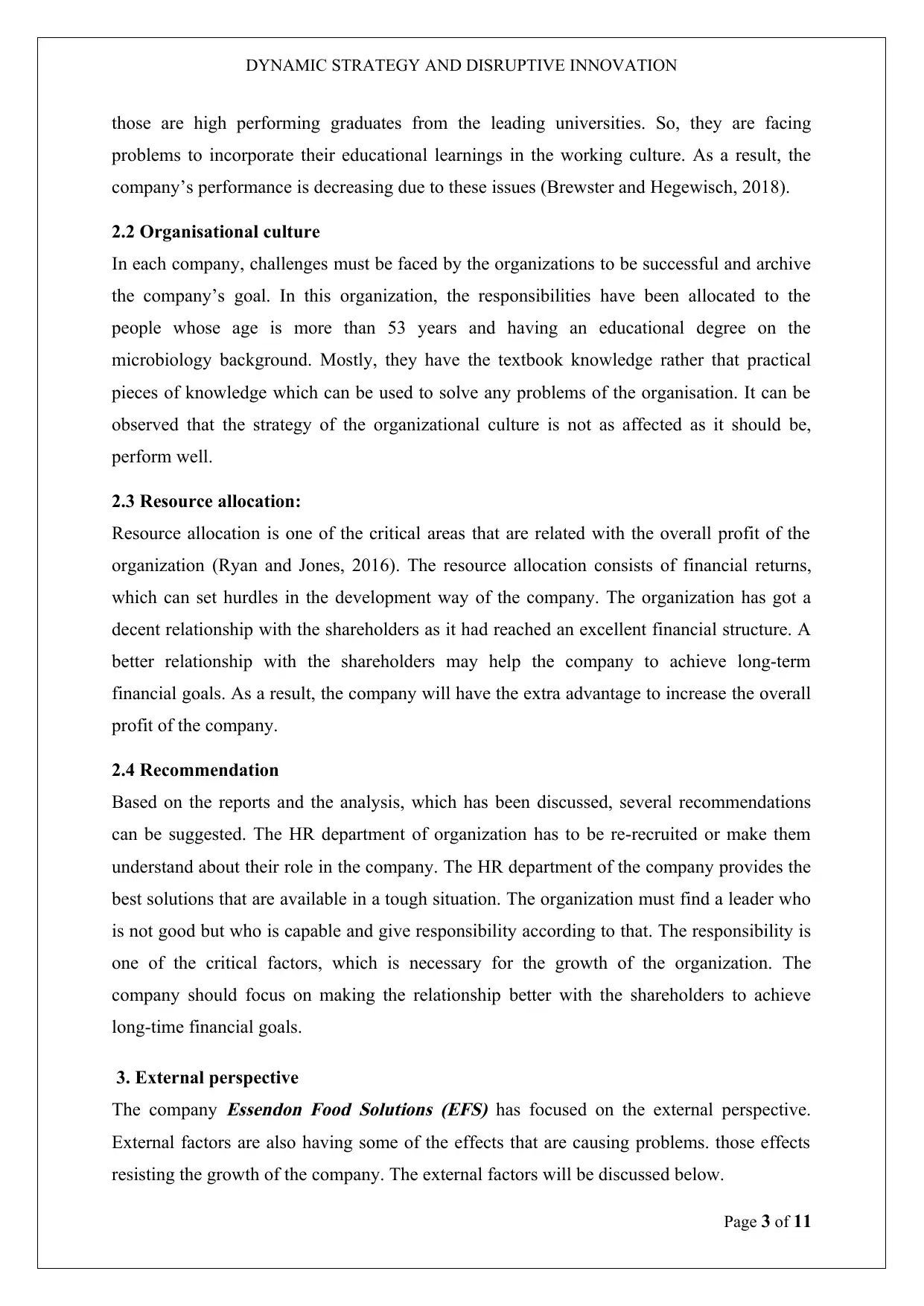
DYNAMIC STRATEGY AND DISRUPTIVE INNOVATION
those are high performing graduates from the leading universities. So, they are facing
problems to incorporate their educational learnings in the working culture. As a result, the
company’s performance is decreasing due to these issues (Brewster and Hegewisch, 2018).
2.2 Organisational culture
In each company, challenges must be faced by the organizations to be successful and archive
the company’s goal. In this organization, the responsibilities have been allocated to the
people whose age is more than 53 years and having an educational degree on the
microbiology background. Mostly, they have the textbook knowledge rather that practical
pieces of knowledge which can be used to solve any problems of the organisation. It can be
observed that the strategy of the organizational culture is not as affected as it should be,
perform well.
2.3 Resource allocation:
Resource allocation is one of the critical areas that are related with the overall profit of the
organization (Ryan and Jones, 2016). The resource allocation consists of financial returns,
which can set hurdles in the development way of the company. The organization has got a
decent relationship with the shareholders as it had reached an excellent financial structure. A
better relationship with the shareholders may help the company to achieve long-term
financial goals. As a result, the company will have the extra advantage to increase the overall
profit of the company.
2.4 Recommendation
Based on the reports and the analysis, which has been discussed, several recommendations
can be suggested. The HR department of organization has to be re-recruited or make them
understand about their role in the company. The HR department of the company provides the
best solutions that are available in a tough situation. The organization must find a leader who
is not good but who is capable and give responsibility according to that. The responsibility is
one of the critical factors, which is necessary for the growth of the organization. The
company should focus on making the relationship better with the shareholders to achieve
long-time financial goals.
3. External perspective
The company
Essendon Food Solutions (EFS) has focused on the external perspective.
External factors are also having some of the effects that are causing problems. those effects
resisting the growth of the company. The external factors will be discussed below.
Page 3 of 11
those are high performing graduates from the leading universities. So, they are facing
problems to incorporate their educational learnings in the working culture. As a result, the
company’s performance is decreasing due to these issues (Brewster and Hegewisch, 2018).
2.2 Organisational culture
In each company, challenges must be faced by the organizations to be successful and archive
the company’s goal. In this organization, the responsibilities have been allocated to the
people whose age is more than 53 years and having an educational degree on the
microbiology background. Mostly, they have the textbook knowledge rather that practical
pieces of knowledge which can be used to solve any problems of the organisation. It can be
observed that the strategy of the organizational culture is not as affected as it should be,
perform well.
2.3 Resource allocation:
Resource allocation is one of the critical areas that are related with the overall profit of the
organization (Ryan and Jones, 2016). The resource allocation consists of financial returns,
which can set hurdles in the development way of the company. The organization has got a
decent relationship with the shareholders as it had reached an excellent financial structure. A
better relationship with the shareholders may help the company to achieve long-term
financial goals. As a result, the company will have the extra advantage to increase the overall
profit of the company.
2.4 Recommendation
Based on the reports and the analysis, which has been discussed, several recommendations
can be suggested. The HR department of organization has to be re-recruited or make them
understand about their role in the company. The HR department of the company provides the
best solutions that are available in a tough situation. The organization must find a leader who
is not good but who is capable and give responsibility according to that. The responsibility is
one of the critical factors, which is necessary for the growth of the organization. The
company should focus on making the relationship better with the shareholders to achieve
long-time financial goals.
3. External perspective
The company
Essendon Food Solutions (EFS) has focused on the external perspective.
External factors are also having some of the effects that are causing problems. those effects
resisting the growth of the company. The external factors will be discussed below.
Page 3 of 11
Paraphrase This Document
Need a fresh take? Get an instant paraphrase of this document with our AI Paraphraser
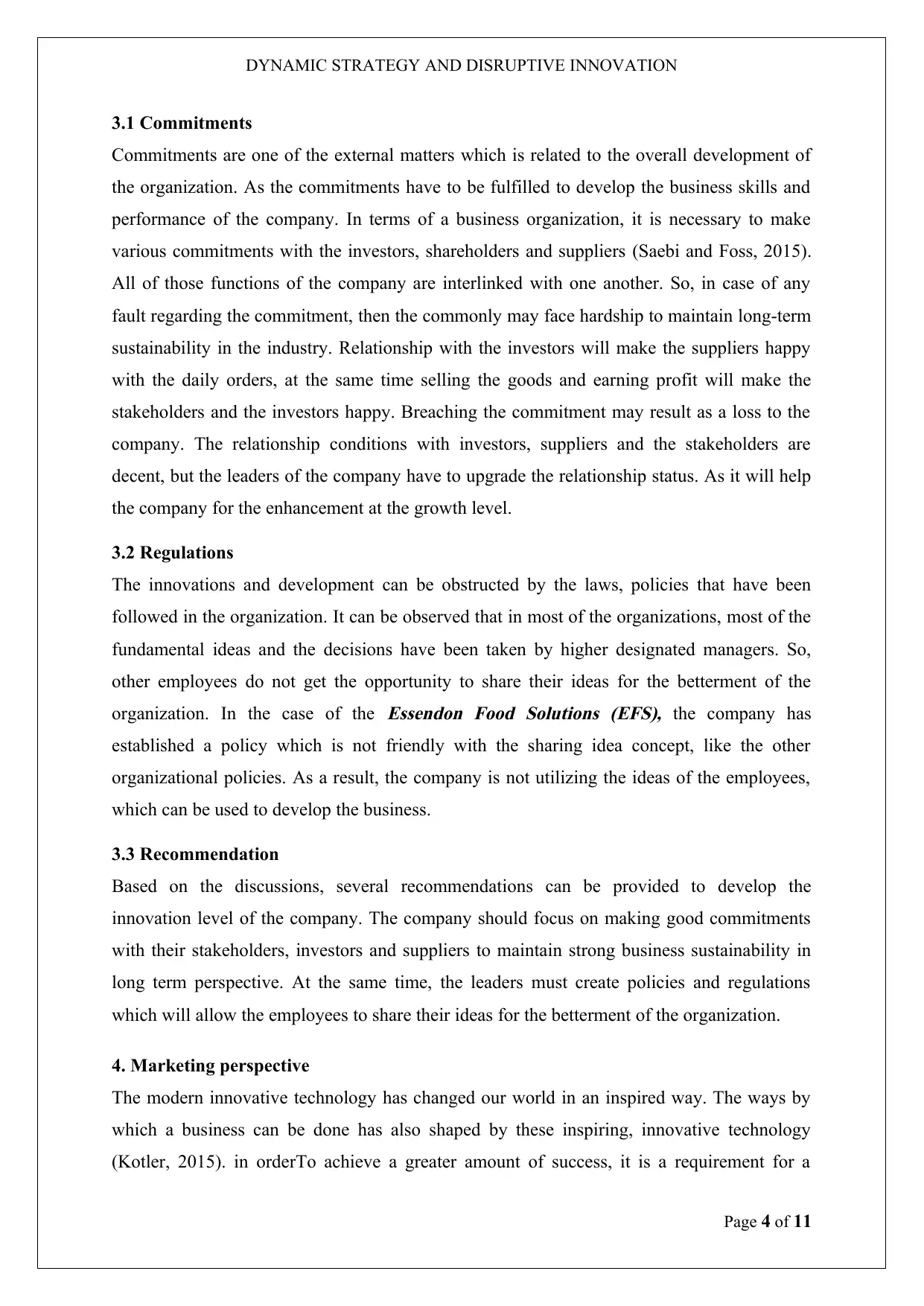
DYNAMIC STRATEGY AND DISRUPTIVE INNOVATION
3.1 Commitments
Commitments are one of the external matters which is related to the overall development of
the organization. As the commitments have to be fulfilled to develop the business skills and
performance of the company. In terms of a business organization, it is necessary to make
various commitments with the investors, shareholders and suppliers (Saebi and Foss, 2015).
All of those functions of the company are interlinked with one another. So, in case of any
fault regarding the commitment, then the commonly may face hardship to maintain long-term
sustainability in the industry. Relationship with the investors will make the suppliers happy
with the daily orders, at the same time selling the goods and earning profit will make the
stakeholders and the investors happy. Breaching the commitment may result as a loss to the
company. The relationship conditions with investors, suppliers and the stakeholders are
decent, but the leaders of the company have to upgrade the relationship status. As it will help
the company for the enhancement at the growth level.
3.2 Regulations
The innovations and development can be obstructed by the laws, policies that have been
followed in the organization. It can be observed that in most of the organizations, most of the
fundamental ideas and the decisions have been taken by higher designated managers. So,
other employees do not get the opportunity to share their ideas for the betterment of the
organization. In the case of the
Essendon Food Solutions (EFS), the company has
established a policy which is not friendly with the sharing idea concept, like the other
organizational policies. As a result, the company is not utilizing the ideas of the employees,
which can be used to develop the business.
3.3 Recommendation
Based on the discussions, several recommendations can be provided to develop the
innovation level of the company. The company should focus on making good commitments
with their stakeholders, investors and suppliers to maintain strong business sustainability in
long term perspective. At the same time, the leaders must create policies and regulations
which will allow the employees to share their ideas for the betterment of the organization.
4. Marketing perspective
The modern innovative technology has changed our world in an inspired way. The ways by
which a business can be done has also shaped by these inspiring, innovative technology
(Kotler, 2015). in orderTo achieve a greater amount of success, it is a requirement for a
Page 4 of 11
3.1 Commitments
Commitments are one of the external matters which is related to the overall development of
the organization. As the commitments have to be fulfilled to develop the business skills and
performance of the company. In terms of a business organization, it is necessary to make
various commitments with the investors, shareholders and suppliers (Saebi and Foss, 2015).
All of those functions of the company are interlinked with one another. So, in case of any
fault regarding the commitment, then the commonly may face hardship to maintain long-term
sustainability in the industry. Relationship with the investors will make the suppliers happy
with the daily orders, at the same time selling the goods and earning profit will make the
stakeholders and the investors happy. Breaching the commitment may result as a loss to the
company. The relationship conditions with investors, suppliers and the stakeholders are
decent, but the leaders of the company have to upgrade the relationship status. As it will help
the company for the enhancement at the growth level.
3.2 Regulations
The innovations and development can be obstructed by the laws, policies that have been
followed in the organization. It can be observed that in most of the organizations, most of the
fundamental ideas and the decisions have been taken by higher designated managers. So,
other employees do not get the opportunity to share their ideas for the betterment of the
organization. In the case of the
Essendon Food Solutions (EFS), the company has
established a policy which is not friendly with the sharing idea concept, like the other
organizational policies. As a result, the company is not utilizing the ideas of the employees,
which can be used to develop the business.
3.3 Recommendation
Based on the discussions, several recommendations can be provided to develop the
innovation level of the company. The company should focus on making good commitments
with their stakeholders, investors and suppliers to maintain strong business sustainability in
long term perspective. At the same time, the leaders must create policies and regulations
which will allow the employees to share their ideas for the betterment of the organization.
4. Marketing perspective
The modern innovative technology has changed our world in an inspired way. The ways by
which a business can be done has also shaped by these inspiring, innovative technology
(Kotler, 2015). in orderTo achieve a greater amount of success, it is a requirement for a
Page 4 of 11
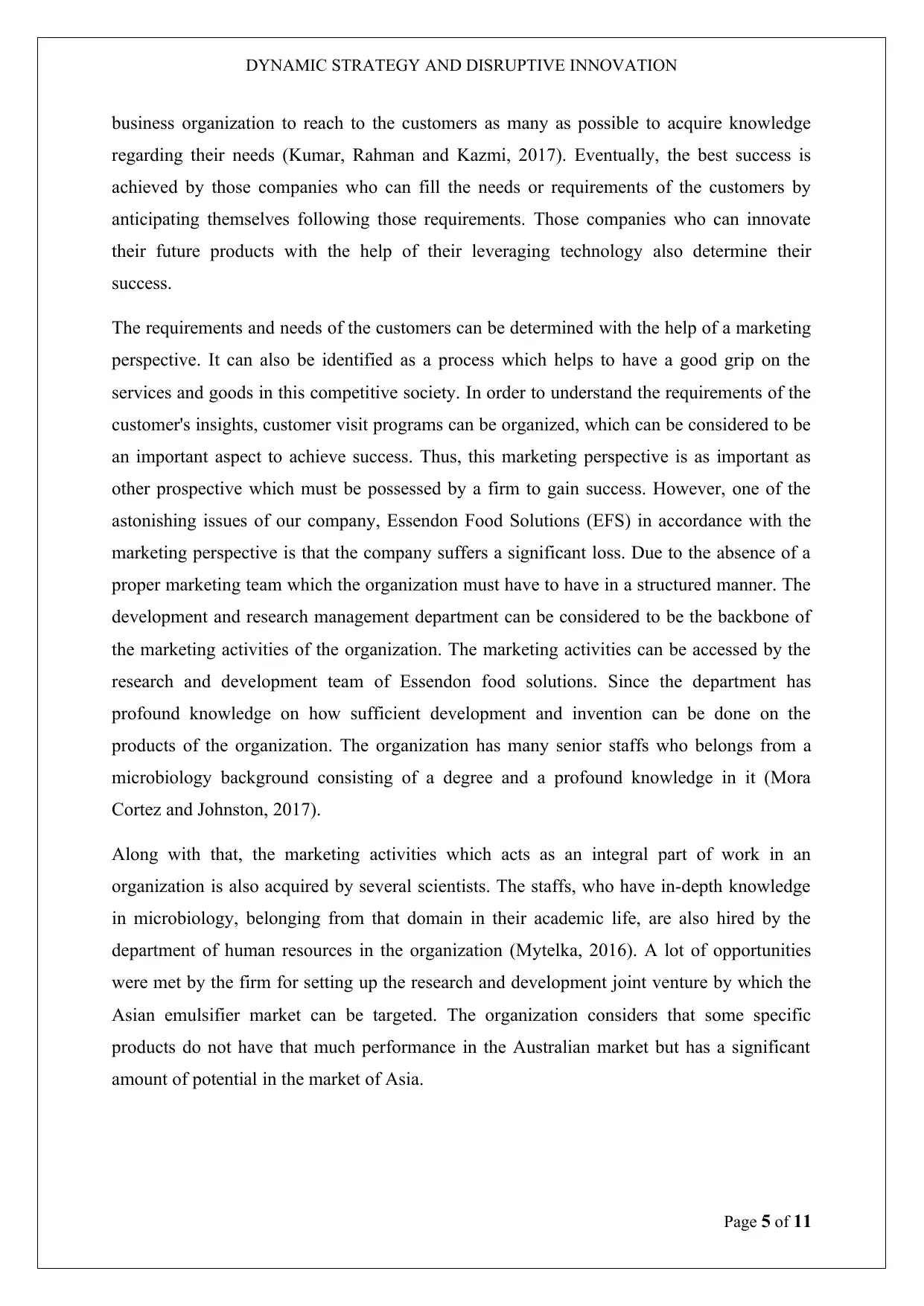
DYNAMIC STRATEGY AND DISRUPTIVE INNOVATION
business organization to reach to the customers as many as possible to acquire knowledge
regarding their needs (Kumar, Rahman and Kazmi, 2017). Eventually, the best success is
achieved by those companies who can fill the needs or requirements of the customers by
anticipating themselves following those requirements. Those companies who can innovate
their future products with the help of their leveraging technology also determine their
success.
The requirements and needs of the customers can be determined with the help of a marketing
perspective. It can also be identified as a process which helps to have a good grip on the
services and goods in this competitive society. In order to understand the requirements of the
customer's insights, customer visit programs can be organized, which can be considered to be
an important aspect to achieve success. Thus, this marketing perspective is as important as
other prospective which must be possessed by a firm to gain success. However, one of the
astonishing issues of our company, Essendon Food Solutions (EFS) in accordance with the
marketing perspective is that the company suffers a significant loss. Due to the absence of a
proper marketing team which the organization must have to have in a structured manner. The
development and research management department can be considered to be the backbone of
the marketing activities of the organization. The marketing activities can be accessed by the
research and development team of Essendon food solutions. Since the department has
profound knowledge on how sufficient development and invention can be done on the
products of the organization. The organization has many senior staffs who belongs from a
microbiology background consisting of a degree and a profound knowledge in it (Mora
Cortez and Johnston, 2017).
Along with that, the marketing activities which acts as an integral part of work in an
organization is also acquired by several scientists. The staffs, who have in-depth knowledge
in microbiology, belonging from that domain in their academic life, are also hired by the
department of human resources in the organization (Mytelka, 2016). A lot of opportunities
were met by the firm for setting up the research and development joint venture by which the
Asian emulsifier market can be targeted. The organization considers that some specific
products do not have that much performance in the Australian market but has a significant
amount of potential in the market of Asia.
Page 5 of 11
business organization to reach to the customers as many as possible to acquire knowledge
regarding their needs (Kumar, Rahman and Kazmi, 2017). Eventually, the best success is
achieved by those companies who can fill the needs or requirements of the customers by
anticipating themselves following those requirements. Those companies who can innovate
their future products with the help of their leveraging technology also determine their
success.
The requirements and needs of the customers can be determined with the help of a marketing
perspective. It can also be identified as a process which helps to have a good grip on the
services and goods in this competitive society. In order to understand the requirements of the
customer's insights, customer visit programs can be organized, which can be considered to be
an important aspect to achieve success. Thus, this marketing perspective is as important as
other prospective which must be possessed by a firm to gain success. However, one of the
astonishing issues of our company, Essendon Food Solutions (EFS) in accordance with the
marketing perspective is that the company suffers a significant loss. Due to the absence of a
proper marketing team which the organization must have to have in a structured manner. The
development and research management department can be considered to be the backbone of
the marketing activities of the organization. The marketing activities can be accessed by the
research and development team of Essendon food solutions. Since the department has
profound knowledge on how sufficient development and invention can be done on the
products of the organization. The organization has many senior staffs who belongs from a
microbiology background consisting of a degree and a profound knowledge in it (Mora
Cortez and Johnston, 2017).
Along with that, the marketing activities which acts as an integral part of work in an
organization is also acquired by several scientists. The staffs, who have in-depth knowledge
in microbiology, belonging from that domain in their academic life, are also hired by the
department of human resources in the organization (Mytelka, 2016). A lot of opportunities
were met by the firm for setting up the research and development joint venture by which the
Asian emulsifier market can be targeted. The organization considers that some specific
products do not have that much performance in the Australian market but has a significant
amount of potential in the market of Asia.
Page 5 of 11
⊘ This is a preview!⊘
Do you want full access?
Subscribe today to unlock all pages.

Trusted by 1+ million students worldwide

DYNAMIC STRATEGY AND DISRUPTIVE INNOVATION
4.1 Recommendation
The perspective of EFS in terms of their marketing is to gain and expand their business. so, it
can be recommended that the organization must supply standard classifiers via distributors
for achieving the required outcomes from the market. Along with that, a technical sales
executive team must be established in the company that can visit their international
customers, regularly, for expanding and establishing a better status on the international
market. By conducting these meetings, internal conflicts, implicit assumptions and poor
communications can be improved in the organization. The marketing objectives can also be
achieved by the collaboration of the marketing department with the R&D department of the
firm.
Page 6 of 11
4.1 Recommendation
The perspective of EFS in terms of their marketing is to gain and expand their business. so, it
can be recommended that the organization must supply standard classifiers via distributors
for achieving the required outcomes from the market. Along with that, a technical sales
executive team must be established in the company that can visit their international
customers, regularly, for expanding and establishing a better status on the international
market. By conducting these meetings, internal conflicts, implicit assumptions and poor
communications can be improved in the organization. The marketing objectives can also be
achieved by the collaboration of the marketing department with the R&D department of the
firm.
Page 6 of 11
Paraphrase This Document
Need a fresh take? Get an instant paraphrase of this document with our AI Paraphraser

DYNAMIC STRATEGY AND DISRUPTIVE INNOVATION
5. Technology perspective
As opined by Dodgson (2018), the strategies regarding the technological aspects are also in
the requirement, in the organization, for disruptive innovation. Rather, the firm can face
several challenges in terms of their technological perspective if those are considered to be the
belongings from new scientific inventions. Apart from those, the company has identified
several issues regarding the R&D department which the firm inspects as a backdated team in
terms of innovative development in research and technology of the firm (Matt, Hess and
Benlian, 2015). Thus, the organization has taken the initiative to develop its R&D department
to keep and sustain the status of the organizational productivity in the market by expanding
its backdated technologies in that department (Luftman, Lyytinen and Zvi, 2017).
However, the department has profound knowledge and experience of the various implications
in Enzymetech. But, that is not only a sufficient quality that the department should have. The
R&d department has a lack of expertise in the company by which a better interaction with the
customers can be held to create better products according to their requirements. On the other
hand, Essendon Emulsifiers, which is be considered to be one of the essential subsidiaries
that the company have, is also facing a lack of performance. Since the technical sales
executives are absent in the organization. Apart from that, it is reported in the organization by
the R&D department that, more than 80 per cent of the R&D staffs are not able to deliver
their quality of work. Since they have a lack of practical experience due to the unavailability
of proper lab instruments in the department.
5.1 Recommendation
The R&D department is considered to be a crucial department, among others. Since an
integral part of the organization depends in terms of achieving success. Thus, the
organization needs to develop the R&D department. The patent analysis can be included for
recognizing the latest technologies from the other corner of the world and to implement those
in the respective sectors in the organization. All of these developments are only possible
when the R&D department of the EFS organization must be improved.
Page 7 of 11
5. Technology perspective
As opined by Dodgson (2018), the strategies regarding the technological aspects are also in
the requirement, in the organization, for disruptive innovation. Rather, the firm can face
several challenges in terms of their technological perspective if those are considered to be the
belongings from new scientific inventions. Apart from those, the company has identified
several issues regarding the R&D department which the firm inspects as a backdated team in
terms of innovative development in research and technology of the firm (Matt, Hess and
Benlian, 2015). Thus, the organization has taken the initiative to develop its R&D department
to keep and sustain the status of the organizational productivity in the market by expanding
its backdated technologies in that department (Luftman, Lyytinen and Zvi, 2017).
However, the department has profound knowledge and experience of the various implications
in Enzymetech. But, that is not only a sufficient quality that the department should have. The
R&d department has a lack of expertise in the company by which a better interaction with the
customers can be held to create better products according to their requirements. On the other
hand, Essendon Emulsifiers, which is be considered to be one of the essential subsidiaries
that the company have, is also facing a lack of performance. Since the technical sales
executives are absent in the organization. Apart from that, it is reported in the organization by
the R&D department that, more than 80 per cent of the R&D staffs are not able to deliver
their quality of work. Since they have a lack of practical experience due to the unavailability
of proper lab instruments in the department.
5.1 Recommendation
The R&D department is considered to be a crucial department, among others. Since an
integral part of the organization depends in terms of achieving success. Thus, the
organization needs to develop the R&D department. The patent analysis can be included for
recognizing the latest technologies from the other corner of the world and to implement those
in the respective sectors in the organization. All of these developments are only possible
when the R&D department of the EFS organization must be improved.
Page 7 of 11

DYNAMIC STRATEGY AND DISRUPTIVE INNOVATION
6. Conclusion
The above-discussed case study is based on the various perspectives of the organization,
Essendon Food Solutions (EFS) regarding its internal, external, marketing and technology.
The interior view is included with human resources, resource allocation, cultures of the
organization and structure of the organization. Along with that, the paper also emphasizes on
several external factors such as commitments and regulations of the organization. On the
other hand, the study also concludes various marketing perspectives of the organization apart
from the internal and external perspective. The way by using which total sale can be
significantly increased with the help of the mentioned marketing perspective is also shown in
the paper. Apart from all of these prospective, the need of separate marketing team catches
the attention of the organization since it plays an essential integral part of the organization to
achieve success. The paper also emphasizes the requirement of this marketing team. In the
last section, the paper addresses several issues in the R&D department and recommends to
overcome those stated problems.
Page 8 of 11
6. Conclusion
The above-discussed case study is based on the various perspectives of the organization,
Essendon Food Solutions (EFS) regarding its internal, external, marketing and technology.
The interior view is included with human resources, resource allocation, cultures of the
organization and structure of the organization. Along with that, the paper also emphasizes on
several external factors such as commitments and regulations of the organization. On the
other hand, the study also concludes various marketing perspectives of the organization apart
from the internal and external perspective. The way by using which total sale can be
significantly increased with the help of the mentioned marketing perspective is also shown in
the paper. Apart from all of these prospective, the need of separate marketing team catches
the attention of the organization since it plays an essential integral part of the organization to
achieve success. The paper also emphasizes the requirement of this marketing team. In the
last section, the paper addresses several issues in the R&D department and recommends to
overcome those stated problems.
Page 8 of 11
⊘ This is a preview!⊘
Do you want full access?
Subscribe today to unlock all pages.

Trusted by 1+ million students worldwide
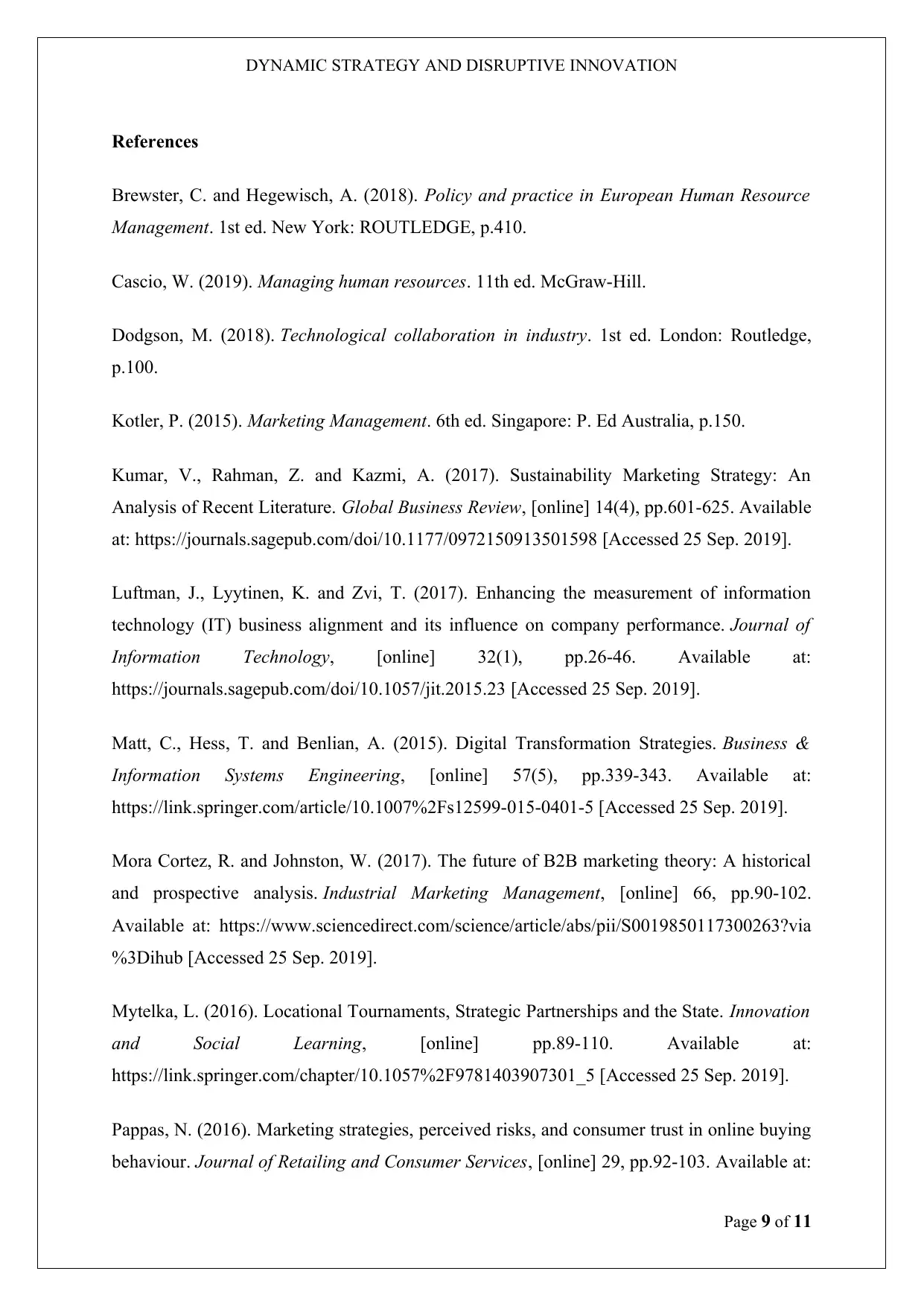
DYNAMIC STRATEGY AND DISRUPTIVE INNOVATION
References
Brewster, C. and Hegewisch, A. (2018). Policy and practice in European Human Resource
Management. 1st ed. New York: ROUTLEDGE, p.410.
Cascio, W. (2019). Managing human resources. 11th ed. McGraw-Hill.
Dodgson, M. (2018). Technological collaboration in industry. 1st ed. London: Routledge,
p.100.
Kotler, P. (2015). Marketing Management. 6th ed. Singapore: P. Ed Australia, p.150.
Kumar, V., Rahman, Z. and Kazmi, A. (2017). Sustainability Marketing Strategy: An
Analysis of Recent Literature. Global Business Review, [online] 14(4), pp.601-625. Available
at: https://journals.sagepub.com/doi/10.1177/0972150913501598 [Accessed 25 Sep. 2019].
Luftman, J., Lyytinen, K. and Zvi, T. (2017). Enhancing the measurement of information
technology (IT) business alignment and its influence on company performance. Journal of
Information Technology, [online] 32(1), pp.26-46. Available at:
https://journals.sagepub.com/doi/10.1057/jit.2015.23 [Accessed 25 Sep. 2019].
Matt, C., Hess, T. and Benlian, A. (2015). Digital Transformation Strategies. Business &
Information Systems Engineering, [online] 57(5), pp.339-343. Available at:
https://link.springer.com/article/10.1007%2Fs12599-015-0401-5 [Accessed 25 Sep. 2019].
Mora Cortez, R. and Johnston, W. (2017). The future of B2B marketing theory: A historical
and prospective analysis. Industrial Marketing Management, [online] 66, pp.90-102.
Available at: https://www.sciencedirect.com/science/article/abs/pii/S0019850117300263?via
%3Dihub [Accessed 25 Sep. 2019].
Mytelka, L. (2016). Locational Tournaments, Strategic Partnerships and the State. Innovation
and Social Learning, [online] pp.89-110. Available at:
https://link.springer.com/chapter/10.1057%2F9781403907301_5 [Accessed 25 Sep. 2019].
Pappas, N. (2016). Marketing strategies, perceived risks, and consumer trust in online buying
behaviour. Journal of Retailing and Consumer Services, [online] 29, pp.92-103. Available at:
Page 9 of 11
References
Brewster, C. and Hegewisch, A. (2018). Policy and practice in European Human Resource
Management. 1st ed. New York: ROUTLEDGE, p.410.
Cascio, W. (2019). Managing human resources. 11th ed. McGraw-Hill.
Dodgson, M. (2018). Technological collaboration in industry. 1st ed. London: Routledge,
p.100.
Kotler, P. (2015). Marketing Management. 6th ed. Singapore: P. Ed Australia, p.150.
Kumar, V., Rahman, Z. and Kazmi, A. (2017). Sustainability Marketing Strategy: An
Analysis of Recent Literature. Global Business Review, [online] 14(4), pp.601-625. Available
at: https://journals.sagepub.com/doi/10.1177/0972150913501598 [Accessed 25 Sep. 2019].
Luftman, J., Lyytinen, K. and Zvi, T. (2017). Enhancing the measurement of information
technology (IT) business alignment and its influence on company performance. Journal of
Information Technology, [online] 32(1), pp.26-46. Available at:
https://journals.sagepub.com/doi/10.1057/jit.2015.23 [Accessed 25 Sep. 2019].
Matt, C., Hess, T. and Benlian, A. (2015). Digital Transformation Strategies. Business &
Information Systems Engineering, [online] 57(5), pp.339-343. Available at:
https://link.springer.com/article/10.1007%2Fs12599-015-0401-5 [Accessed 25 Sep. 2019].
Mora Cortez, R. and Johnston, W. (2017). The future of B2B marketing theory: A historical
and prospective analysis. Industrial Marketing Management, [online] 66, pp.90-102.
Available at: https://www.sciencedirect.com/science/article/abs/pii/S0019850117300263?via
%3Dihub [Accessed 25 Sep. 2019].
Mytelka, L. (2016). Locational Tournaments, Strategic Partnerships and the State. Innovation
and Social Learning, [online] pp.89-110. Available at:
https://link.springer.com/chapter/10.1057%2F9781403907301_5 [Accessed 25 Sep. 2019].
Pappas, N. (2016). Marketing strategies, perceived risks, and consumer trust in online buying
behaviour. Journal of Retailing and Consumer Services, [online] 29, pp.92-103. Available at:
Page 9 of 11
Paraphrase This Document
Need a fresh take? Get an instant paraphrase of this document with our AI Paraphraser
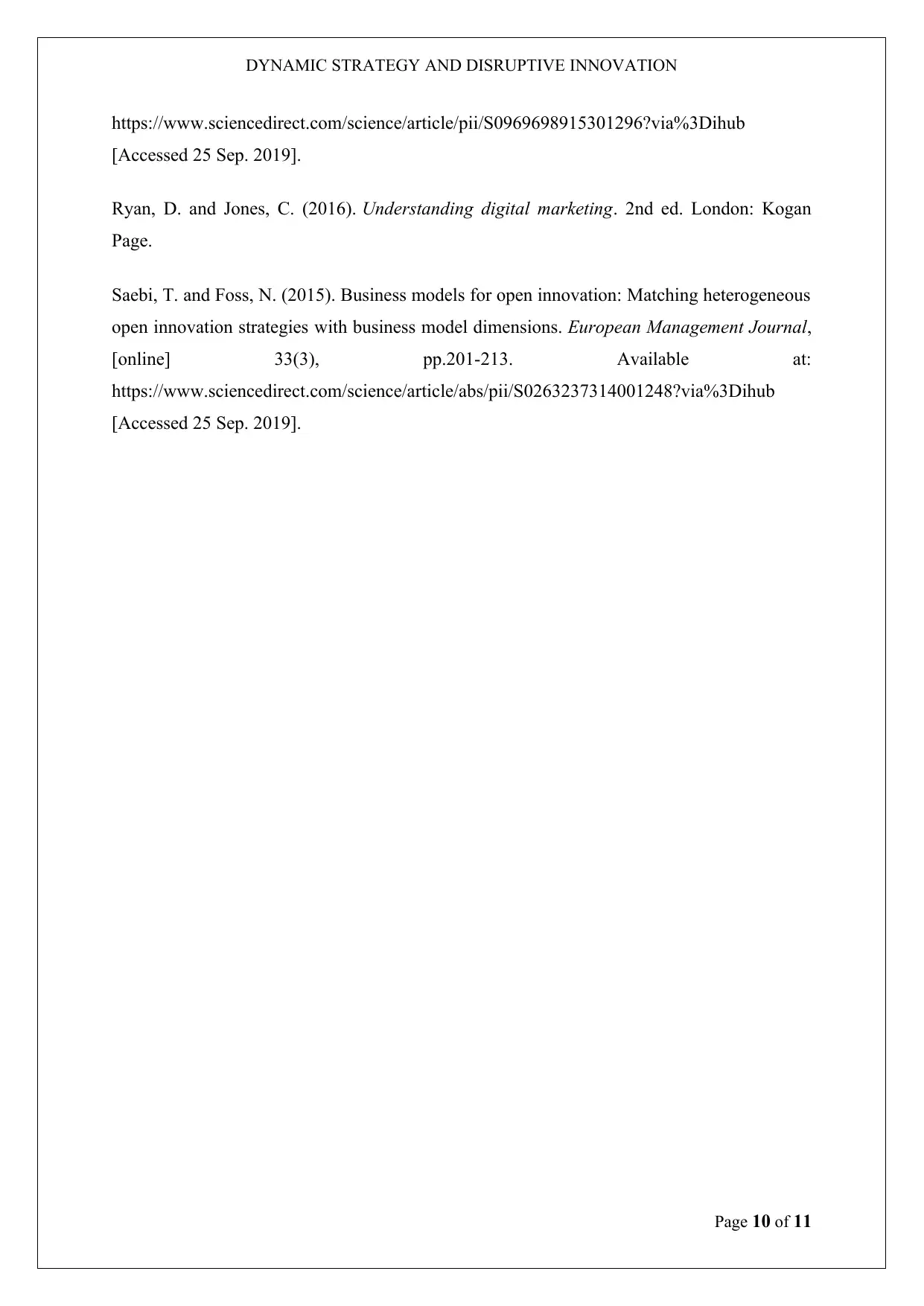
DYNAMIC STRATEGY AND DISRUPTIVE INNOVATION
https://www.sciencedirect.com/science/article/pii/S0969698915301296?via%3Dihub
[Accessed 25 Sep. 2019].
Ryan, D. and Jones, C. (2016). Understanding digital marketing. 2nd ed. London: Kogan
Page.
Saebi, T. and Foss, N. (2015). Business models for open innovation: Matching heterogeneous
open innovation strategies with business model dimensions. European Management Journal,
[online] 33(3), pp.201-213. Available at:
https://www.sciencedirect.com/science/article/abs/pii/S0263237314001248?via%3Dihub
[Accessed 25 Sep. 2019].
Page 10 of 11
https://www.sciencedirect.com/science/article/pii/S0969698915301296?via%3Dihub
[Accessed 25 Sep. 2019].
Ryan, D. and Jones, C. (2016). Understanding digital marketing. 2nd ed. London: Kogan
Page.
Saebi, T. and Foss, N. (2015). Business models for open innovation: Matching heterogeneous
open innovation strategies with business model dimensions. European Management Journal,
[online] 33(3), pp.201-213. Available at:
https://www.sciencedirect.com/science/article/abs/pii/S0263237314001248?via%3Dihub
[Accessed 25 Sep. 2019].
Page 10 of 11
1 out of 11
Related Documents
Your All-in-One AI-Powered Toolkit for Academic Success.
+13062052269
info@desklib.com
Available 24*7 on WhatsApp / Email
![[object Object]](/_next/static/media/star-bottom.7253800d.svg)
Unlock your academic potential
Copyright © 2020–2025 A2Z Services. All Rights Reserved. Developed and managed by ZUCOL.





